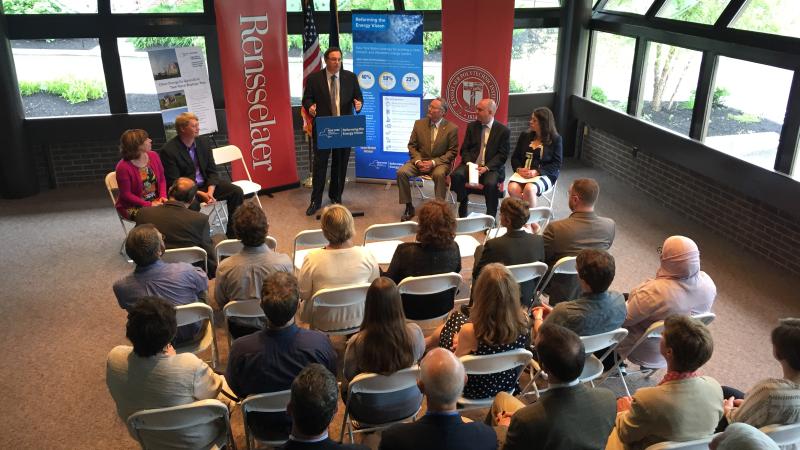Rensselaer Polytechnic Institute, Cornell University, and NYSERDA create a consortium to reduce electricity use in greenhouses up to 70 percent
June 5, 2017

Troy, N.Y. — Today, as consumers demand more locally sourced vegetables and the farm-to-table trend builds momentum, New York greenhouses are faced with conflicting tasks focused on producing more quality vegetables while reducing overall energy consumption. Now, a newly formed public-private consortium called GLASE—The Greenhouse Lighting and Systems Engineering Consortium, led by researchers at Cornell University and Rensselaer Polytechnic Institute (RPI)—is being launched to transform the way greenhouses operate in order to reduce electricity use by 70 percent. The announcement was made during a press conference held on the Rensselaer campus.
The seven-year, $5 million project funded by the New York State Energy Research and Development Authority (NYSERDA) will advance Governor Andrew M. Cuomo’s Clean Energy Standard that aims to have 50 percent of electricity come from renewable energy sources by 2030.
Plant physiology expert Tessa Pocock, who serves as a senior research scientist at the Center for Lighting Enabled Systems & Applications (LESA), will lead the work at Rensselaer. Pocock is fascinated by photosynthesis and has conducted research with plants in both academic and industry settings. “The engineered LED lighting and sensing systems with advanced feedback control are being pioneered at LESA. Integrated with Cornell’s advanced greenhouse management technologies, GLASE has the potential to create a more sustainable and profitable greenhouse industry. The systems engineering expertise at LESA and the agriculture expertise at Cornell make this an ideal partnership.”
Neil Mattson, the lead investigator of GLASE at Cornell and associate professor in the Horticulture Section of the School of Integrative Plant Science, will partner with Pocock to demonstrate a holistic greenhouse energy management system that integrates control of LED lighting, carbon dioxide supplementation, ventilation, and humidity. “This investment in energy-efficient greenhouse production will help ensure New York’s continued leadership in local food production in the Northeast,” said Mattson. “Increasing the amount of food grown indoors creates opportunities for agriculture in places where it was never possible before.”
Mattson, who directs the Controlled Environment Agriculture group in the College of Agriculture and Life Sciences, said reactive lighting made possible with LED technologies allows growers to provide optimal lighting even as conditions change throughout the day. His research at the Kenneth Post and Guterman greenhouse facilities on campus will determine precise LED light conditions needed by tomatoes and lettuce as model plants. Mattson and his team also will study how tomato and strawberry growth responds to carbon dioxide supplementation.
Greenhouses, which currently cover 720 acres in New York state, extend the growing season and protect crops and other plants from harsh weather conditions. Recent U.S. Department of Agriculture census data shows the cultivation of lettuce and tomatoes, two profitable crops well-suited for greenhouse production, increased in New York by 10.6 percent per year from 2007 to 2012. Since 2012, rapid growth in greenhouse production continues.
“New York state’s greenhouse industry is experiencing rapid growth, making quick and meaningful action key to ensuring new and existing greenhouses are energy-efficient and highly productive,” said John B. Rhodes, president and CEO, NYSERDA. “The consortium’s work will advance Governor Cuomo’s energy goals and New York’s vital agriculture sector.”
Already, more than 30 potential participants have expressed interest in joining the consortium, including growers, lighting and fixture manufacturers, trade groups, supermarket produce buyers, horticultural suppliers, and research organizations. The consortium is structured so it will become self-sustaining within seven years.
LESA’s vision is focused on creating digitized illumination for new applications in lighting, healthcare, building management, horticulture, and advanced 5G wireless communications platforms. The launch of GLASE further exemplifies The New Polytechnic, an emerging paradigm for teaching, learning, and research at Rensselaer. The New Polytechnic emphasizes and supports collaboration across disciplines, sectors, and regions to address the great global challenges of our day, using the most advanced tools and technologies, many of which are developed at Rensselaer. Research at Rensselaer addresses some of the world’s most pressing technological challenges—from energy security and sustainable development to biotechnology and human health. The New Polytechnic is transformative in the global impact of research, in its innovative pedagogy, and in the lives of students at Rensselaer.
About the Center for Lighting Enabled Systems & Applications (LESA) ERC
Funded primarily by the National Science Foundation (NSF), the LESA Engineering Research Center (ERC) is an interdisciplinary, multi-university center developing “Smart Lighting Systems that See and ThinkTM”. The center engages faculty members, graduate students, research staff, and undergraduates to work on research leading to smart lighting systems with adaptive and controllable properties that will change the way society uses lighting. The center joins academia, industry, and government in partnership to produce transformational engineered systems, along with engineering graduates who are adept at innovation and primed for leadership in the global economy. The LESA ERC is headquartered at Rensselaer Polytechnic Institute in Troy, N.Y., and partners with Boston University, the University of New Mexico, and Thomas Jefferson University to achieve its objectives. http://lesa.rpi.edu
About Rensselaer Polytechnic Institute
Rensselaer Polytechnic Institute, founded in 1824, is America’s first technological research university. For nearly 200 years, Rensselaer has been defining the scientific and technological advances of our world. Rensselaer faculty and alumni represent 85 members of the National Academy of Engineering, 17 members of the National Academy of Sciences, 25 members of the American Academy of Arts and Sciences, 8 members of the National Academy of Medicine, 8 members of the National Academy of Inventors, and 5 members of the National Inventors Hall of Fame, as well as 6 National Medal of Technology winners, 5 National Medal of Science winners, and a Nobel Prize winner in Physics. With 7,000 students and nearly 100,000 living alumni, Rensselaer is addressing the global challenges facing the 21st century—to change lives, to advance society, and to change the world. To learn more, go to www.rpi.edu.